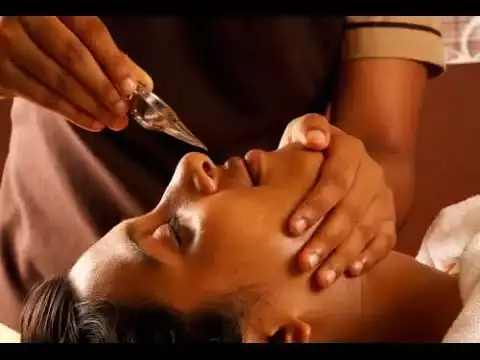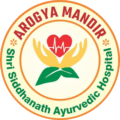Nasya Chikitsa

Ayurveda, the ancient Indian system of medicine, offers a plethora of holistic approaches to well-being, and one such gem is the Nasya therapy. In this comprehensive guide, we will delve into the roots, practices, and benefits of Nasya, an intricate therapeutic method that has stood the test of time.
Introduction Of Nasya Therapy
Definition of Nasya Ayurvedic Treatment
Nasya, derived from the Sanskrit word “Nasa,” meaning nose, is a specialized Ayurvedic therapy focused on nasal administration of herbal oils and other natural substances. It is a crucial component of Panchakarma, the detoxification and rejuvenation process in Ayurveda.
Core Principles
Nasya operates on the principle of ‘Prana,’ the vital life force, and aims to channelize it through the nasal passages to stimulate various physiological and psychological functions. This therapy also works on Marma point which is located inside of nasal cavity This process is believed to enhance the body’s innate healing capabilities.
Types of Nasya
1. Pradhamana (Errhine)
This type involves the use of dry powders like herbal snuff to induce sneezing, effectively cleansing the nasal passages and improving respiratory functions.
2. Bruhana (Nutrient)
In Bruhana Nasya, medicated oils or ghee are administered to nourish and strengthen the nasal tissues, promoting better nasal health and overall well-being.
3. Shamana (Alleviating)
Shamana Nasya focuses on alleviating specific dosha imbalances, employing a tailored blend of herbs and oils to restore equilibrium.
How Nasya therapy Works
Nasya Procedure
A. Preparation
Before initiating Nasya, careful preparation is crucial. This involves creating a serene environment conducive to relaxation, ensuring the availability of the required oils or powders, and most importantly, consulting with a qualified Ayurvedic practitioner. The consultation is essential for determining the appropriate substances, techniques, and frequencies tailored to an individual’s specific health needs.
B. Application Techniques
1. Pratimarsha Nasya
Pratimarsha Nasya is a daily practice involving the application of a small amount of oil or ghee to the nostrils. This routine serves to maintain nasal hygiene, prevent imbalances, and promote overall well-being. The daily nature of Pratimarsha Nasya makes it a supportive measure for ongoing nasal care.
2. Marsha Nasya
In Marsha Nasya, a larger quantity of medicated oil or ghee is administered to address specific health concerns, offering a more intensive therapeutic effect. This technique is employed for targeted benefits, such as alleviating particular doshic imbalances, respiratory issues, or neurological conditions. The increased quantity enhances the therapeutic impact for more pronounced results.
3. Navana Nasya
Navana Nasya involves the application of herbal juices or medicated oils, carefully selected based on an individual’s constitution and health requirements. This technique tailors the therapeutic intervention to the unique needs of the person, offering a customized approach for addressing specific health conditions. Navana Nasya is often more specialized and may be recommended for more complex or chronic concerns.
The selection of the appropriate Nasya technique depends on various factors, including the individual’s health goals, constitution, and the nature of the health issues being addressed. Each technique offers a unique approach to nasal administration, ranging from daily maintenance to targeted and personalized therapeutic interventions.
C. Nasya Therapy Post Care:
- Marma Abhyanga: Generally after administration of Nasya Therapy, practitioner apply Marma on nose, forehead and near ear. This helps to stimulate more Marma points.
- Sleeping on same position: Individuals who received Nasya therapy is advised to sleep on same position for next 1 to 2 minutes.
- Hot water gargle (if needed): If person wants to gargle for removing dosha then he must gargle with warm water. Warmness of water helps to clear passage and liquify Kapha dosha.
Conditions Treated
Respiratory Disorders
Nasya proves highly effective in addressing a range of respiratory issues, including sinusitis, allergies, and asthma. The therapy’s capacity to clear nasal passages plays a pivotal role in enhancing respiratory function, providing relief to individuals grappling with various respiratory disorders.
Neurological Issues
In Ayurveda, the profound connection between nasal passages and the brain is acknowledged. Nasya is believed to exert positive effects on neurological conditions, fostering mental clarity and cognitive functions. The application of herbal substances through the nasal route is thought to influence the nervous system, contributing to overall neurological well-being.
Cervical spondylosis
Nasya therapy in cervical spondylosis offers a potential adjunctive approach by leveraging its anti-inflammatory properties to reduce inflammation in the cervical spine, improving blood circulation to support natural healing processes, and balancing Vata dosha to address the root cause. Additionally, Nasya’s positive impact on the nervous system may provide relief from symptoms like radiating pain and numbness, contributing to pain management in individuals dealing with cervical spondylosis.
Migraine
Benefits of Nasya
Improved Breathing
Clearing nasal passages and enhancing respiratory health result in improved breathing. Nasya is particularly beneficial for individuals with chronic respiratory conditions or seasonal allergies, as it aids in reducing congestion and promoting unobstructed airflow.
Mental Clarity
Nasya’s impact on balancing Vata dosha contributes to mental clarity, focus, and emotional well-being. It is often recommended for individuals dealing with stress and anxiety, providing a holistic approach to supporting mental health.
Enhanced Immunity
The detoxification initiated by Nasya plays a pivotal role in strengthening the immune system. By expelling toxins through the nasal passages, Nasya helps fortify the body’s defenses, making it more resilient to infections and diseases. This immune-boosting effect contributes to overall well-being and preventive health measures.
DIY Nasya at Home
Safe Practices
While professional guidance is recommended, there are safe practices for DIY Nasya at home. This includes using mild oils, ensuring cleanliness, and following proper techniques.
Materials Needed
For DIY Nasya, you’ll need medicated oils or ghee, a dropper or nasal spray, and a comfortable, quiet space to perform the procedure.
Step-by-Step Guide
- Preparation: Ensure a calm environment and gather necessary materials.
- Positioning: Sleep comfortably, keeping the head slightly tilted back.
- Application: Administer the oil or ghee into each nostril using the dropper or nasal spray. 2 drops are sufficient for each nasal cavity.
- Breathing: Inhale deeply to allow the medicinal substances to reach the respiratory system.
- Rest: Stay in a relaxed position for a few minutes, allowing the benefits to take effect.
FAQs
Nasya is generally safe, but pregnant women, those with acute illnesses, or specific nasal conditions should consult a healthcare professional before undergoing the therapy.
The frequency of Nasya treatments depends on individual health needs and practitioner recommendations. It can range from a daily practice for maintenance to more intensive treatments as needed.
While rare, some individuals may experience mild side effects like nasal irritation or sneezing. These typically subside quickly, but it’s essential to inform the practitioner if any discomfort persists.
Yes, with proper guidance and suitable materials, Nasya can be done at home. However, seeking professional advice is recommended for optimal results.
Uniqueness of our therapies
At Arogya Mandir – Shri Siddhanath Ayurvedic Hospital, Miraj, we delve deeply into the ayurvedic examination of each patient. Utilizing noninvasive Ayurvedic diagnostic tools such as Ashtavidha Parikshan and Nadi Parikshan, we precisely determine the pathogenesis of the disease and then prescribe therapies tailored to the specific condition. This approach leads to expedited results.
Our therapies boast the following distinctive features:
– Tranquil and hygienic therapy rooms staffed with trained therapists in a positive environment.
– Selection of appropriate massage oil based on the patient’s Prakruti and the condition of the disease.
– Complimentary Prakruti and Dhatu Sarata examinations before the commencement of therapies.
– Authenticated procedures for each therapy.
– Judicious use of herbal medicines and instruments during the therapy sessions.
– Specialized rooms equipped with all facilities for inpatient care.
Feel free to share this article at no cost.
Copyright message – Dr. Prashant Chivate has published this article on drchivateayurved.org for informational purposes about diseases. Any other use of this article is strictly prohibited. All rights reserved.
